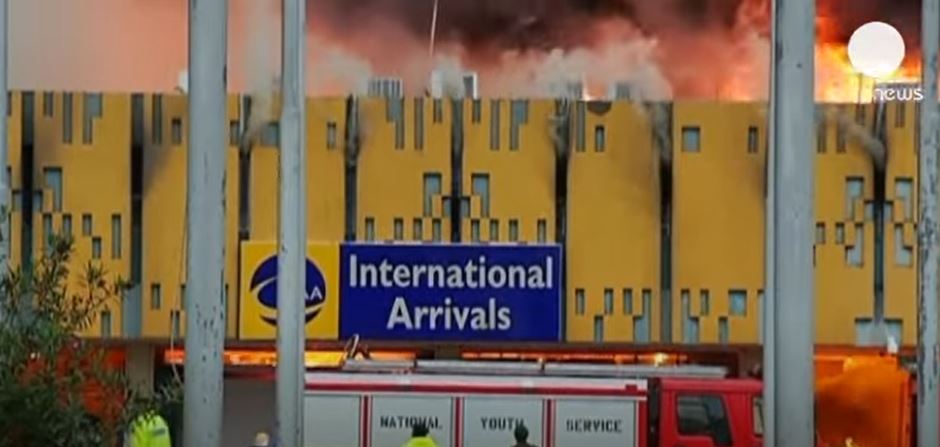Visitors intending to reach the official website should visit kaa.go.ke
The Jomo Kenyatta International Airport (JKIA) has experienced several fire incidents over the years, with the most notable ones occurring in 2013, 2014, and most recently in 2024. Among these, the 2013 fire stands out as the most extensive and destructive. Starting in the early hours of August 7, 2013, the blaze rapidly spread through the international terminal, leading to a complete shutdown of one of Africa’s busiest airports.
The Fire Breaks Out at JKIA in 2013
The fire that engulfed Jomo Kenyatta International Airport (JKIA) on August 7, 2013, remains one of the most significant disasters in Kenyan aviation history. The blaze started early in the morning, around 04:30 AM, in the Simba Lounge of the International Arrivals area and quickly escalated due to an inadequate initial response and lack of proper firefighting equipment.
More details…
At approximately 4:30 am on that fateful Wednesday, a fire broke out in the immigration section of Unit I, which handled international departures. Initially, the fire was reported to be small and localized in the Simba Lounge, where it was believed to have started. However, due to inadequate initial response, the fire quickly spread to Unit II, which served international arrivals. The fire ravaged these two key sections of the airport, severely disrupting operations.
Events Leading to the Fire
The fire began as a small, seemingly manageable blaze. It reportedly started in the Simba Lounge, which, at the time, housed a VIP waiting area. Initially, staff and emergency personnel underestimated the fire’s potential. For three critical hours, as arrivals and departures continued at the airport, the fire grew, spreading uncontrollably and engulfing the entire Immigration and Arrivals area.
The Initial Response
The response to the fire was hindered by several factors, including the age and design of the terminal building, which was constructed in 1978. Structural weaknesses such as a roof collapse in Unit I further complicated efforts to control the blaze. Additionally, there was significant congestion around the airport, making it difficult for emergency vehicles to reach the scene. Alarmingly, early media reports depicted firefighters using buckets to battle the growing inferno, painting a grim picture of the available resources. Water hydrants at the airport were reportedly running dry, severely hampering efforts to contain the blaze.
Underequipped Fire Response
The 2013 fire at JKIA exposed critical shortcomings in Kenya’s and specifically Nairobi’s disaster preparedness. The fire, which began in the Simba Lounge of the International Arrivals area, quickly escalated due to a delayed and poorly equipped response. Firefighters from various agencies arrived promptly but were unable to control the blaze effectively, highlighting significant equipment shortages.
Crucially, fire engines struggled to pump water to the upper floors, and although hydrants were functioning, they provided insufficient water. As reported by the Standard, prominent Kenyan Newspaper, the sight of 200 military personnel using buckets to fight the fire underscored the lack of modern firefighting resources. Airport personnel also used handheld fire extinguishers, endangering their lives due to inadequate protective gear.
Coordination between different agencies, including the Kenya Army, G4S, and National Youth Service, was also poor. Access to the airport was further delayed by blocked roads, slowing the emergency response.
The fire burned for more than six hours, devastating the Arrivals terminal 1E and forcing flight diversions to Eldoret and Mombasa. It highlighted the need for better equipment, coordination, and disaster preparedness at JKIA. In the aftermath, there were calls for significant investment in modern firefighting systems and improved emergency response protocols to prevent future disasters at such a critical transport hub.
Widespread Chaos and Grounded Flights
As the fire spread through JKIA, the situation escalated into chaos. All flights to and from Nairobi were canceled or rerouted. Flights already en route to JKIA were diverted to Eldoret and Mombasa, where passengers waited in uncertainty. With international and domestic travel severely disrupted, thousands of passengers were stranded, their plans in limbo.
Kenya Airways, JKIA’s primary tenant, swiftly suspended operations and confirmed that no flights would be departing or arriving at the airport. Flights to key destinations, including Lagos, Johannesburg, London, and Dubai, were delayed indefinitely. The global travel network also felt the ripples of this event, as several international airlines canceled flights to Nairobi, causing widespread confusion and logistical headaches for passengers.
The Full Extent of the Damage
As the fire raged on for over six hours, emergency responders finally managed to contain it. However, the damage had been done. The immigration and arrivals areas were completely destroyed, and much of the airport infrastructure was rendered unusable. To add insult to injury, reports surfaced that some first responders had looted businesses and shops damaged by the fire, leading to allegations that the fire could have been brought under control sooner if all hands had been focused on fighting the blaze.
Passengers’ Ordeal
For many travelers, the experience was not only frustrating but also dangerous. Some tourists attempting to retrieve their belongings from the airport reported being assaulted by thugs who had taken advantage of the chaotic situation to loot and harass passengers. Access to the main gates was blocked by these criminals, adding to the confusion and fear among those displaced by the fire.
Immediate Recovery Efforts
In the wake of the disaster, the government, led by President Uhuru Kenyatta, took immediate steps to restore operations at JKIA. Makeshift immigration desks and temporary terminals were set up in large tents outside the damaged sections of the airport. These measures were aimed at clearing the massive backlog of passengers waiting to fly in and out of Nairobi. Despite the hurried setup, passengers reported that the temporary arrangements were remarkably efficient, with many expressing surprise at the speed with which they were processed.
A Silver Lining
The swift recovery efforts were praised by many, given the scale of the disaster. Domestic flights resumed the same evening, and limited international flights followed shortly after. Kenya Airways and other airlines quickly adapted to the new situation, rerouting flights through the makeshift terminals. By the end of the first week after the fire, operations were steadily returning to a semblance of normalcy.
Investigation and Cause of the Fire
Initially, there were concerns that the fire might have been the result of a terrorist attack, particularly given that the fire occurred on the fifteenth anniversary of the 1998 U.S. embassy bombings in Nairobi and Dar es Salaam. Kenya had also been involved in ongoing military operations against Al-Shabaab in Somalia, adding to fears of an intentional attack. However, after a thorough investigation, terrorism was ruled out as the cause. The fire was ultimately attributed to an electrical fault in a distribution board within the immigration area.
Long-Term Impacts and Future Developments
The fire at JKIA highlighted the need for better disaster preparedness and infrastructural upgrades. President Kenyatta announced plans to fast-track the construction of Unit 4 and accelerate the upgrading of the three existing units. A temporary terminal with a capacity of 2.5 million passengers was also commissioned as an emergency measure to cope with the disruption.
Construction of Terminal 2 (“Greenfield”)
The Greenfield Terminal project, designed to accommodate an additional 20 million passengers annually, was also set to commence later in 2013 as part of the broader efforts to expand and modernize JKIA but 11 years later in 2024, this has not commenced. This expansion is crucial for JKIA to maintain its position as a major aviation hub in Africa, which had been significantly jeopardized by the fire.
Lessons Learned and Looking Forward
While the fire exposed significant gaps in JKIA’s emergency response capabilities, it also prompted meaningful reforms. The Kenya Airports Authority faced widespread criticism for its lack of preparedness, with calls for major management changes. It became evident that JKIA needed not only better fire safety protocols but also more advanced firefighting equipment and disaster management systems to prevent future incidents.
In the aftermath, there was a renewed focus on the importance of modernizing Kenya’s critical infrastructure. The resilience of JKIA’s operations in the face of such a disaster speaks volumes about the determination of the staff and the government to restore normalcy and improve future safety standards.
As we look back on the 2013 fire, it serves as a somber reminder of the fragility of our beloved JKIA but also of the strength and resolve to rebuild and recover.
2014 JKIA Fire Incident: Electrical Fault in Terminal 1E
In March 25 2014, another fire at JKIA disrupted operations after an electrical fault caused a blaze in Terminal 1E, used for international arrivals and departures. The Kenya Airports Authority (KAA) confirmed that the fire was promptly contained, and there were no injuries or casualties. As a precaution, power to Terminal 1E was temporarily shut off.
To minimize disruptions, all flight operations originally scheduled for Terminal 1E were redirected to Terminal 1A. However, this caused overcrowding and inconvenience to travelers as the airport adjusted to the temporary closure.
The airport’s circular design, featuring Terminals 1A, 1B, 1C, and 1E, made it possible to reroute passengers effectively, though congestion was an issue. KAA assured the public that safety remained a priority, and efforts were made to resume normal operations swiftly.
This incident underscored the importance of addressing electrical safety to prevent future disruptions and highlighted JKIA’s preparedness in swiftly containing fires and ensuring passenger safety.
2024 Fire Incident at JKIA Terminal 1E
In early 2024, a fire caused by an electrical fault at Jomo Kenyatta International Airport’s Terminal 1E led to a temporary closure and evacuation. The Star reported reopening of Terminal 1E the same day- March 25, 2024 -when fire incident occured.
The Kenya Airports Authority (KAA) swiftly contained the fire, and there were no reported injuries or casualties. As a precaution, power to Terminal 1E was shut off.
To manage the situation and minimize disruptions, all flight operations, including those for major carriers such as British Airways, Qatar Airways, Emirates, and Lufthansa, were redirected to Terminal 1A. This caused some inconvenience due to overcrowding. After safety checks and repairs, Terminal 1E was fully reopened, and operations returned to normal.
This incident highlighted JKIA’s ability to swiftly manage emergencies, ensuring safety while mitigating operational disruptions.
JKIA Airport Fire Today?
As of today, there is no fire or any significant disruptions at Jomo Kenyatta International Airport (JKIA). However, recent concerns have emerged surrounding a strike linked to the ongoing discussions about the potential Adani Group takeover of JKIA’s operations.
While the strike has caused minor delays in certain services, particularly around ground handling and airport logistics, flight schedules have largely remained unaffected. Travelers are advised to monitor updates from their airlines and JKIA’s official communication channels to stay informed about any potential changes. The airport remains operational, and contingency plans have been put in place to minimize disruptions and ensure passenger safety and convenience.
We’ll keep you posted on this site, JKIAirport.com on any new developments including fire incidences at JKIA.

